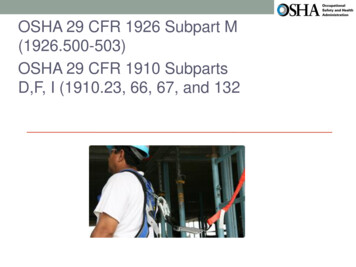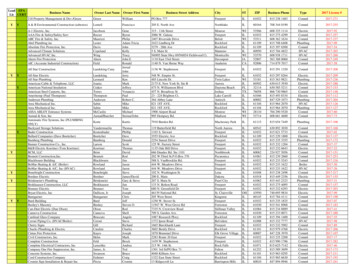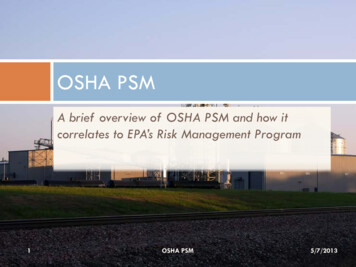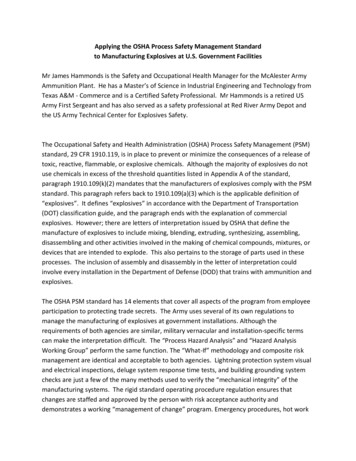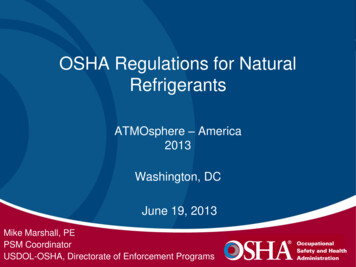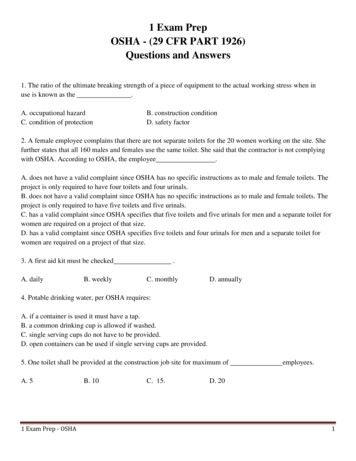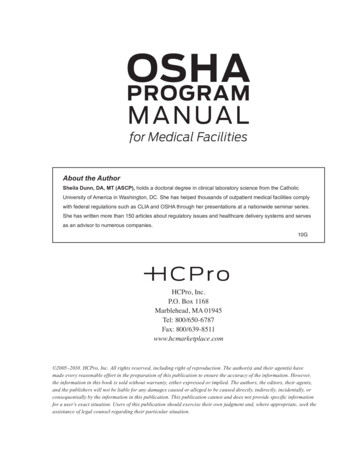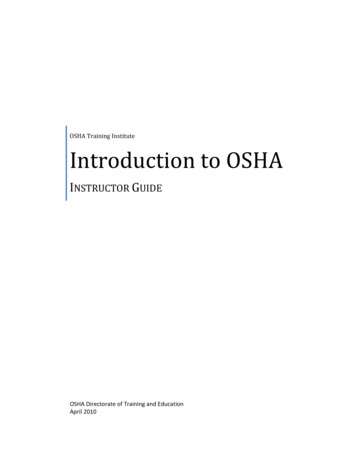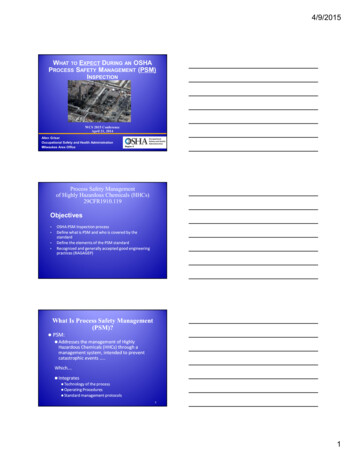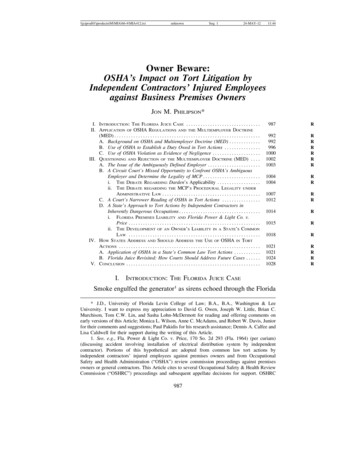
Transcription
eq: 124-MAY-1211:44Owner Beware:OSHA’s Impact on Tort Litigation byIndependent Contractors’ Injured Employeesagainst Business Premises OwnersJON M. PHILIPSON*I. INTRODUCTION: THE FLORIDA JUICE CASE . . . . . . . . . . . . . . . . . . . . . . . . . . . . . . .II. APPLICATION OF OSHA REGULATIONS AND THE MULTIEMPLOYER DOCTRINE(MED) . . . . . . . . . . . . . . . . . . . . . . . . . . . . . . . . . . . . . . . . . . . . . . . . . . . . . . . . . . . . .A. Background on OSHA and Multiemployer Doctrine (MED) . . . . . . . . . . . . .B. Use of OSHA to Establish a Duty Owed in Tort Actions . . . . . . . . . . . . . . .C. Use of OSHA Violation as Evidence of Negligence . . . . . . . . . . . . . . . . . . . .III. QUESTIONING AND REJECTION OF THE MULTIEMPLOYER DOCTRINE (MED) . . . .A. The Issue of the Ambiguously Defined Employer . . . . . . . . . . . . . . . . . . . . . .B. A Circuit Court’s Missed Opportunity to Confront OSHA’s AmbiguousEmployer and Determine the Legality of MCP . . . . . . . . . . . . . . . . . . . . . . . .i. THE DEBATE REGARDING Darden’s Applicability . . . . . . . . . . . . . . . . . .ii. THE DEBATE REGARDING THE MCP’S PROCEDURAL LEGALITY UNDERADMINISTRATIVE LAW . . . . . . . . . . . . . . . . . . . . . . . . . . . . . . . . . . . . . . . . .C. A Court’s Narrower Reading of OSHA in Tort Actions . . . . . . . . . . . . . . . .D. A State’s Approach to Tort Actions by Independent Contractors inInherently Dangerous Occupations . . . . . . . . . . . . . . . . . . . . . . . . . . . . . . . . . .i. FLORIDA PREMISES LIABILITY AND Florida Power & Light Co. v.Price . . . . . . . . . . . . . . . . . . . . . . . . . . . . . . . . . . . . . . . . . . . . . . . . . . . . . . .ii. THE DEVELOPMENT OF AN OWNER’S LIABILITY IN A STATE’S COMMONLAW . . . . . . . . . . . . . . . . . . . . . . . . . . . . . . . . . . . . . . . . . . . . . . . . . . . . . . .IV. HOW STATES ADDRESS AND SHOULD ADDRESS THE USE OF OSHA IN TORTACTIONS . . . . . . . . . . . . . . . . . . . . . . . . . . . . . . . . . . . . . . . . . . . . . . . . . . . . . . . . . . .A. Application of OSHA in a State’s Common Law Tort Actions . . . . . . . . . . .B. Florida Juice Revisited: How Courts Should Address Future Cases . . . . . .V. CONCLUSION . . . . . . . . . . . . . . . . . . . . . . . . . . . . . . . . . . . . . . . . . . . . . . . . . . . . . . . N: THE FLORIDA JUICE CASESmoke engulfed the generator1 as sirens echoed through the Florida* J.D., University of Florida Levin College of Law; B.A., B.A., Washington & LeeUniversity. I want to express my appreciation to David G. Owen, Joseph W. Little, Brian C.Murchison, Tom C.W. Lin, and Sasha Lohn-McDermott for reading and offering comments onearly versions of this Article; Monica L. Wilson, Anne C. McAdams, and Robert W. Davis, Juniorfor their comments and suggestions; Paul Pakidis for his research assistance; Dennis A. Calfee andLisa Caldwell for their support during the writing of this Article.1. See, e.g., Fla. Power & Light Co. v. Price, 170 So. 2d 293 (Fla. 1964) (per curiam)(discussing accident involving installation of electrical distribution system by independentcontractor). Portions of this hypothetical are adopted from common law tort actions byindependent contractors’ injured employees against premises owners and from OccupationalSafety and Health Administration (“OSHA”) review commission proceedings against premisesowners or general contractors. This Article cites to several Occupational Safety & Health ReviewCommission (“OSHRC”) proceedings and subsequent appellate decisions for support. OSHRC987
wnSeq: 2UNIVERSITY OF MIAMI LAW REVIEW24-MAY-1211:44[Vol. 66:987Juice and Chemical Company’s (“Florida Juice”) Deland, Florida compound.2 The fire from the accident engulfed Bobby Roberts, anemployee of Independent Electric hired by Florida Juice to clean andrepair its electrical generator. Eventually, the fire was snuffed,3 and theambulance, which carried the deceased Bobby Roberts, quietly droveaway.4Soon after Bobby’s death, the Occupational Safety and HealthAdministration (“OSHA”)5 investigated the accident, in which Bobbyfell from Independent Electric’s unsecured scaffolding6 while cleaningand repairing Florida Juice’s generator.7 Even though Bobby’s Independent Electric supervisor warned him that the generator was energized,8Bobby, who lacked protective equipment,9 still grabbed the generator’swires10 to brace his fall,11 causing his electrocution.12 Dan Alderman, aFlorida Juice plant manager and Independent Electric’s contact,informed the investigator that he visited the worksite the day of the accident to assess Independent Electric’s progress,13 but that he did notproceedings and subsequent appellate court decisions are often cited by courts addressing the useof OSHA in tort litigation. See, e.g., Teal v. E.I. DuPont de Nemours & Co., 728 F.2d 799 (6thCir. 1984); Horn v. C.L. Osborne Contracting Co., 591 F.2d 318 (5th Cir. 1979). Multiple times,this Article cites to tort cases and OSHRC proceedings in the same footnote; however, it cautionsthat tort cases and OSHRC proceedings involve different procedural requirements and othernuanced differences. For the purpose of this Article, these differences are not dispositive to theanalysis of the Multiemployer Doctrine. As well, for clarity, this Article’s evaluation of OSHA’srelevance to state tort actions, in particular Florida’s, is limited to the non-construction industrycontext.2. See Jeter v. St. Regis Paper Co., 507 F.2d 973 (5th Cir. 1975) (discussing accident onowner’s premises involving independent contractor’s employee).3. See Merritt v. Bethlehem Steel Corp., 875 F.2d. 603 (7th Cir. 1989) (involving injury toindependent contractor’s employee during cleaning of electrical equipment).4. See Lake Parker Mall, Inc. v. Carson, 327 So. 2d 121 (Fla. Dist. Ct. App. 1976)(involving death of independent contractor’s employee from electric shock).5. For discussion of the history of OSHA, see infra Part II.A.6. See Horton v. Gulf Power Co., 401 So. 2d 1384, 1385 (Fla. Dist. Ct. App. 1981)(involving fall from unsecured scaffolding).7. See Merritt, 875 F.2d. at 604 (involving injury to independent contractor’s employeeduring cleaning of electrical equipment).8. See id. (involving warning of energized electrical system); Lake Parker Mall, Inc., 327So. 2d at 123–26 (same).9. See Calloway v. PPG Indus., Inc., 155 F. App’x 450, 452, 455 (11th Cir. 2005) (percuriam) (discussing lack of fall protection equipment); Pearson v. Harris, 449 So. 2d 339, 340–41(Fla. Dist. Ct. App. 1984) (discussing duty owed to provide protective equipment).10. See Lake Parker Mall, Inc., 327 So. 2d 121 (involving death of independent contractor’semployee from electrocution); Fla. Power & Light Co. v. Price, 170 So. 2d 293 (Fla. 1964) (percuriam) (involving electrocution).11. See Horton, 401 So. 2d at 1385 (involving fall from unsecured scaffolding).12. See Merritt, 875 F.2d at 604 (involving electric shock during fall).13. See Skow v. Dep’t of Transp., 468 So. 2d 422, 424 (Fla. Dist. Ct. App. 1985) (involvinginspection of progress by owner).
nownOWNER BEWARESeq: 324-MAY-1211:44989instruct Independent Electric’s workers regarding their work14 or potential electrical hazards.15 Moreover, Alderman emphasized that he did notnotice the hazard because he was unversed in electrical repair.16 Independent Electric’s contract also did not require Florida Juice to monitoror correct Independent Electric’s safety violations but did require Independent Electric to comply with OSHA standards.17 Based on its investigation, OSHA cited Independent Electric for two violations—the failureto supply adequate safety equipment18 and proper scaffolding.19 However, OSHA did not cite Florida Juice for any violation.After OSHA’s investigation, Bobby’s widow discovered that Independent Electric did not carry workmen’s compensation insurance.20Therefore, Bobby’s estate brought, in Florida’s Seventh Judicial Circuit,a wrongful death action21 against Independent Electric and Florida Juice.The estate alleged that Florida Juice was an employer under OSHA22and therefore owed a duty to provide Bobby with protective equipmentand safe scaffolding.23 The estate explained that because Florida Juice’sDeland compound was a multiemployer worksite,24 Florida Juice could14. See id. (involving instructions given by owner); IBP, Inc. v. Herman, 144 F.3d 861 (D.C.Cir. 1998) (involving instruction and recognition of hazards by owner); Turner v. Scott Paper Co.,No. 94-0284-P-M, 1995 U.S. Dist LEXIS 6768, at *3, *11–*12 (S.D. Ala. Mar. 17, 1995),adopted by No. 94-0284-P-M, 1995 U.S. Dist. LEXIS 6769, at *2 (S.D. Ala. May 18, 1995)(involving right to inspect).15. See Lowe v. United States, 466 F. Supp. 895 (M.D. Fla. 1979) (discussing owner’s dutywhen recognizing hazard not created by owner).16. See Horton, 401 So. 2d at 1387 (Smith, C.J., concurring) (discussing superiorknowledge).17. See Skow, 468 So. 2d at 424 (discussing independent contractor’s contractual requirementto comply with federal safety standards).18. See 29 C.F.R. § 1910.335 (2011) (stating employees working in areas of potentialelectrical hazards are to be provided electrical protective equipment).19. See 29 C.F.R. § 1910.28 (2011) (specifying the safety requirements for safe scaffolding).20. In Florida, an employer, as defined by § 440.02 of the Florida Statutes, must carryworkmen’s compensation insurance to cover damages suffered by an injured employee in thecourse of his employment. See generally FLA. STAT. ch. 440 (2012) (setting forth applications andlimitations of “Florida’s Workmen’s Compensation Law”). Workmen’s compensation insurance isan employee’s exclusive remedy, except if the employer does not carry workmen’s compensationinsurance. See FLA. STAT. § 440.11 (2012). In such a case, the employer is subject to actions atlaw or admiralty. Id.; Elliott v. S.D. Warren Co, 134 F.3d 1 (1st Cir. 1998); Kane v. J.R. SimplotCo., 60 F.3d 688 (10th Cir. 1995); see also Tracy Nichols, Comment, Florida Workers’Compensation: Does Common Employer Concept Unjustly Limit Employees’ Claims againstThird-Party Tortfeasors?, 34 FLA. L. REV. 463, 464–66 (1982) (explaining purpose behindFlorida’s Workers’ Compensation law).21. See FLA. STAT. §§ 768.16–768.26 (2011) (setting forth the “Florida Wrongful DeathAct”).22. 29 U.S.C. § 652(5) (2006) (stating in pertinent part that “‘employer’ means a personengaged in a business affecting commerce who has employees”). For further discussion regardingOSHA’s definition of employer, see infra note 52.23. For discussion of OSHA’s purpose, see infra Part II.A.24. A “Multiemployer worksite” is a workplace where multiple employers are working in a
wnSeq: 4UNIVERSITY OF MIAMI LAW REVIEW24-MAY-1211:44[Vol. 66:987be deemed Bobby’s employer under OSHA and thus, owe Bobby a dutyof care.25 Moreover, the estate alleged that even if no duty was owed, anOSHA violation could be used as evidence of negligence by FloridaJuice.26In light of previous court opinions, the estate’s argument is heretofore questionable.27 In fact, to date, the Court of Appeals for the Eleventh Circuit has not directly addressed in a binding opinion whetherOSHA’s Multiemployer Doctrine (“MED”) or its Multiemployer Citation Policy (“MCP”) may be used to impose a duty of care on a businesspremises owner28 for an independent contractor’s injured employee in anon-construction industry tort action.The genesis of this quandary—whether the MED or the MCP maybe used as a basis for imposing a duty of care on a business premisesowner—dates back to when OSHA first began to cite employers at multiemployer construction worksites when those employer’s employeeswere not the ones exposed to the harm by the employer’s violation ofOSHA regulations. At that time, rather than engaging in informalrulemaking to establish a multiemployer citation scheme, OSHA reliedon interpretations by the Secretary of Labor and holdings by the Occupational Safety & Health Review Commission (“OSHRC”) affirmingthese citations. As a result, employers have continuously questionedunder the Administrative Procedure Act (“APA”) the validity of theMED and the MCP scheme. Moreover, an externality of this citationscheme has been plaintiffs in tort actions using these citations and theoverarching MED to argue that OSHA may be used to impose a duty ofcare on a business premises owner with regards to an independent contractor’s injured employee or that at the very least, an OSHA violationmay be used as evidence of negligence.This Article attempts to articulate that because OSHA did notengage in informal rulemaking to formulate its current MED and MCP,common undertaking, typically found in the construction industry. See generally John Zebrowski,Comment, OSHA: Developing Outlines of Liability in Multi-employer Situations, 62 GEO. L.J.1483 (1974) (discussing multiemployer worksites under OSHA).25. See Teal v. E.I. DuPont de Nemours & Co., 728 F.2d 799 (6th Cir. 1984) (involvingargument that premises owner owed duty under OSHA).26. See Elliott, 134 F.3d at 5 (discussing OSHA violation as evidence of negligence); Merrittv. Bethlehem Steel Corp., 875 F.2d 603, 604–05 (7th Cir. 1989) (same).27. See IBP, Inc. v. Herman, 144 F.3d 861 (D.C. Cir. 1998); Elliott, 134 F.3d 1; Kane v. J.R.Simplot Co., 60 F.3d 688 (10th Cir. 1995); Cochran v. Int’l Harvester Co., 408 F. Supp. 598, 602(W.D. Ky. 1975); Hare v. Fed. Compress & Warehouse Co., 359 F. Supp. 214 (N.D. Miss. 1973);France v. S. Equip. Co. 689 S.E.2d 1 (W. Va. 2010); Hall v. Dieffenwierth, No. 2-07-058-CV,2008 WL 2404462 (Tex. Ct. App. June 12, 2008); Vickers v. Hanover Constr. Co., 875 P.2d 832(Idaho 1994); Tanksley v. Ala. Gas Corp., 568 So. 2d 731 (Ala. 1990).28. In this Article, “premises owner” means a business premises owner and not a residentialpremises owner.
nownOWNER BEWARESeq: 524-MAY-1211:44991negative externalities have ensued—an inefficient allocation ofresources and responsibilities between business premises owners andindependent contractors and costly and needless litigation.29 As a result,the MCP, which emphasizes construction situations in its examples andexplanations, and the overarching MED, which traditionally is used inthe construction context, are being employed in non-construction settings, preventing business premises owners from proper notice of itsapplicability.30 This Article further argues that even if OSHA did engagein proper rulemaking, a greater issue would still exist. That issue is oneof generality versus reasonable specificity. Although one general rule orregulation for a multiemployer citation scheme would be efficient, thisArticle argues that OSHA should revisit its MCP scheme and promulgate a more nuanced multiemployer citation scheme, through notice andcomment rulemaking, that tailors the MCP to various industries andworksites generally. Therefore, with a more nuanced citation scheme, allparties affected will have greater notice of potential citations and the useof that potential exposure as a source of potential liability in tort litigation. This idea is not unprecedented; in the 1980s and 1990s, OSHApromulgated multiple regulations that specifically addressed multiem-29. This argument about vagueness is akin to the idea of fair notice; however, this Articleuses the idea in a more general sense. See Gen. Elec. v. EPA, 53 F.3d 1324, 1329 (D.C. Cir. 1995)(“[E]lementary fairness compels clarity in the statements and regulations setting forth the actionswith which the agency expects the public to comply” (internal quotations and citations omitted)).See generally Timothy A. Wilkins, Regulatory Confusion, Ignorance of Law, and Deference toAgencies: General Electric Co. v. EPA, 49 SMU L. REV. 1561 (1996) (discussing “regulatoryconfusion” and the use of the fair notice argument in administrative law cases); Albert C. Lin,Refining Fair Notice Doctrine: What Notice is Required of Civil Regulations?, 55 BAYLOR L.REV. 991 (2003) (discussing the fair notice doctrine).30. See OCC. SAFETY AND HEALTH ADMIN., DEP’T OF LABOR, CPL 02-00-124, OSHAINSTRUCTION: MULTIEMPLOYER CITATION POLICY (Dec. 10, 1999); see also Citation Guidelines inMulti-employer Worksites, 41 Fed. Reg. 17639, 17639–40 (proposed Apr. 7, 1976) (emphasizingconstruction industry); Gary S. Marx, Note, The Occupation Safety and Health Act of 1970 asApplied to the Construction Industry: The Multi-employer Worksite Problem, 35 WASH. & LEE L.REV. 173, 191 n.116 (1978) (noting that although the Citation Guidelines are not expressly limitedto the construction industry, the limitation seems implied based on the actions of the Secretary ofLabor). Regarding the MED’s limited use, one court has even stated, “[t]he duty on one employerto comply with OSHA standards for the benefit of employees of another employer [in upheldOSHRC decisions], however, has only been expressly recognized in the multiemployerconstruction worksite context.” Am. Petroleum Inst. v. Occ. Safety & Health Admin., 581 F.2d493, 509 (5th Cir. 1978) (emphasis added). American Petroleum is binding precedent in theEleventh Circuit, being decided prior to the Fifth Circuit split. See Bonner v. City of Prichard,Ala., 661 F.2d 1206, 1209 (11th Cir. 1981) (en banc) (adopting Fifth Circuit’s body of law asexisted on September 30, 1981 as binding precedent).Again, this Article’s evaluation of OSHA’s relevance to state tort actions, in particularFlorida, is limited to the non-construction industry context. For a discussion regarding use of theMED in construction cases, see generally Marx, supra, at 173 (discussing use of MED inconstruction industry violations).
wnSeq: 6UNIVERSITY OF MIAMI LAW REVIEW24-MAY-1211:44[Vol. 66:987ployer situations involving certain substances or products.31 However, aslong as the MCP and the overarching MED continue in their currentform, this Article argues that costly litigation and inefficient allocationof resources will continue as business premises owners incessantly fightagainst the use of OSHA in tort proceedings. However, with a clearerand more precise MED and MCP, American workers will be safer.Using Florida as a model state, this Article explains why, untilOSHA addresses its MCP and general MED scheme, states should notuse OSHA regulations to impose a duty of care on premises owners,such as Florida Juice,32 in tort actions brought by independent contractors’ injured employees. This Article also addresses why, until OSHAaddresses its MCP and general MED scheme, states should not permitthe use of OSHA violations as evidence of negligence. Part II provides abackground on OSHA and the MED and discusses the application ofOSHA regulations and the MED in tort actions to date. Part III chronicles recent challenges to the MED and uses Florida as a model state todiscuss how Florida common law and statutory law regarding hazardousoccupations impose a limited duty of care on business premises ownersabsent the MED. Then, Part IV, by using Florida and its previous applications of OSHA in tort actions as a model state and by revisiting theFlorida Juice hypothetical in light of the prior sections’ doctrines, illustrates how the MED’s broad application causes confusion. Part V concludes by discussing the policy implications of this Article’s analysisand sets forth a charge for regulatory reform.II.APPLICATIONOFOSHA REGULATIONS ANDDOCTRINE (“MED”)THEMULTIEMPLOYERA. Background on OSHA and Multiemployer Doctrine (“MED”)Under the Occupational Safety and Health Act of 1970 (“Act” or“OSHA”), Congress attempted “to assure
wires10 to brace his fall,11 causing his electrocution.12 Dan Alderman, a . OSHA’s definition of employer, see infra note 52. 23. For discussion of OSHA’s purpose, see infra Part II.A. 24. A “Multiemployer worksite”

